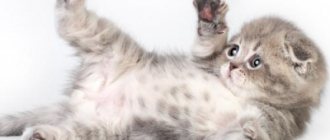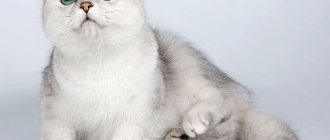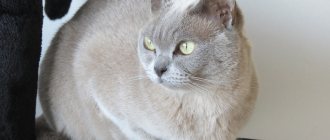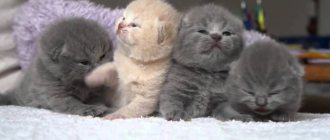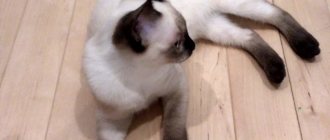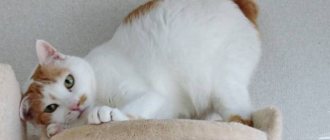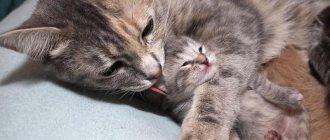The Scottish Straight cat (also called Scottish Straight) looks like a British cat, but they deserve to be called Scottish. These creatures are very balanced and extremely loyal to their owners.
Babies of this breed will bring many pleasant surprises to those who decide to have them, since it has long been believed that these cats, with their unique character, become guarantors of peace and harmony at home. This is interesting - Scottish fold kittens, character and care.
Breed characteristics
What is the difference between a Scottish Straight and a British cat?
Scottish Straights resemble the British cat, and they can even be confused, but there are differences between them:
- the straight body is more elongated and graceful, the weight is less;
- the shape of the “Scotsman’s” muzzle is round;
- straights are more mobile and flexible.
The eyes of this breed can be: blue, amber, orange, green, brown, but they are always combined with the color of the fur coat.
The colors vary and are as follows:
- plain,
- tortoiseshell (also called tricolor, bringing happiness),
- marble,
- tabby,
- striped,
- ticked,
- bicolor
The Straight's paws are of medium length, and so is the tail. Their fur, although short, is soft and pleasant, because it’s not for nothing that people call these cats plush.
General feeding rules
- Breed name: Scottish Fold cat (Scottish Fold).
- Country of origin: Scotland / UK.
- Weight: 4–5 kg.
- Height at withers: up to 30 cm.
- Average life expectancy: up to 15 years.
- Average price: 5–20 thousand rubles.
At the very beginning of their lives, Scottish cat babies feed exclusively on their mother's milk, so feeding such a pet does not cause problems. This period lasts several weeks, after which any breed of cat, including the Scottish Fold, can be fed one of three main types of food:
- exclusively natural and fresh food products;
- dry or jelly-like ready-made food;
- proper mixed diet.
As a replacement for mother's cat's milk, special adapted formulations can be used, as well as some self-prepared mixtures based on:
- 250 ml of concentrated milk, half an egg yolk and a couple of teaspoons of fructose;
- 100 ml cow's whole milk, 30 g whole milk powder and 5.0 g dry yeast;
- 100-110 ml of whole milk, 100-110 g of boiled milk, raw egg yolk and a couple of teaspoons of corn oil.
When choosing a feeding method, it is necessary to take into account the taste preferences of your pet, and also focus on the availability of a sufficient amount of free time required for independent cooking. A kitten aged one and a half to two months should be fed five times a day.
It is also permissible to provide such a pet with free access to food. By about six months, the number of feedings is gradually reduced to three times a day, and starting from eight months, the kitten is transferred to two meals a day. The food given to your pet must be fresh and at a comfortable room temperature. Among other things, the kitten should have access to clean drinking water at all times.
- The basis of the menu should be meat. Natural food or ready-made food: pay close attention to the composition and quality of raw materials.
- Artificial additives, dyes, spices, salt, stabilizers, flavors and sugar are prohibited. By excluding them, you will ensure the natural development and good health of your pet.
- Provide the Scot with water. This is the most important feeding rule.
- Make sure the food is at room temperature and the correct consistency. It is better to give crushed food to Scottish kittens up to 3 months old. Closer to 6 months, they switch to large pieces, which will ensure normal development of the jaw muscles.
The Scots, together with the British, have long dictated the rules of home etiquette. Not only its health depends on how carefully you pay attention to feeding a kitten, and then an adult cat. A satisfied pet who is satisfied with the contents of the bowl will become a source of peace and well-being in your family.
History of the breed
The first representative of the Scottish Straight breed was little Susie. The unusualness of the cat was noticed by the Great Briton William Ross. It was this cat that was noticed on one of the private Scottish farms in the 19th century - it had ears of an unusual shape.
The animal was a carrier of a special mutation gene (FdFd), due to which the ears were folded. It was from this that the Scottish Fold (loose-eared Scots) breed originated.
A more detailed history of the origin of Scottish cats can be read in the article about the Scottish Fold.
Special ready-made food: what to prefer
The most important rule in this case is that the food must be “premium class”. Even if such food is more expensive, it will definitely not cause harm and will be beneficial
As for the consistency, breeders especially like to feed their little charges mousse - it is most convenient to eat.
Food for babies must be designed for their age, since pellets for adult animals are larger and, as a result, inconvenient
As for brands, you should pay attention to the following:
- “Hills” - contains phosphorus, magnesium, calcium in excellent balance. It has a medicinal line of foods available, but you should first consult with a veterinarian about the advisability of using them.
- "Royal Canin" - contains enough fiber and an acceptable dosage of quickly digestible proteins. Helps create an optimal balance of intestinal flora and normalize the animal's stool.
- “Innova EVO” is favored by experienced breeders due to its composition of fresh meat and vegetables, oils, minerals, and vitamins. Fats and oils have a good effect on the immunity of kittens, and the absence of harmful impurities and even taste and smell enhancers guarantees high quality food.
- “Matisse” - most of the composition is chicken meat and fat, rice, fish, eggs. In addition, the food contains a whole complex of vitamins and calcium.
Scottish is a breed that attracts with its beauty and dignity
However, for all this, just a good pedigree is not enough - care is also of no small importance. But there is nothing complicated about the issue of proper feeding if you figure it out in advance and don’t improvise on the fly
Previous Scottish Straight (Scottish Straight) Buying a Scottish Straight - selection and prices Next Scottish Straight (Scottish Straight) Health of the Scottish Straight - diseases, prevention, vaccinations and basic information
Character and psychology
Scottish Straights are obedient cats. Usually representatives of the straight breed independently understand what is possible and what is not. But even if the animal suddenly makes the wrong decision, you can always point out his mistake and explain to him what he did wrong. Surprisingly, cats understand everything perfectly the first time.
Scottish Straights are not demanding, tolerate loneliness calmly, and do not require increased attention. They can easily stay home alone if you provide them with food and toys.
Animals choose one favorite from among their owners, whom they will love until the end of their days, and treat others with condescension.
They are loyal to other pets, including dogs.
These pets will not ruin new wallpaper or furniture. Cats love to watch what is happening around them. They are quite passive, easily adapt to everything new, but are afraid of heights.
Cats are quite smart and always get what they want. Cute pets need affection and stroking, but they absolutely cannot stand being held.
New people in the house do not scare cats. They talk infrequently, their voice can only be heard when they beg for a treat. In a word, this breed can be called ideal. The main thing is that the cat has food and toys.
What should you not feed?
Whatever the fate of the Scottish kitten - with its mother or breastfeeding, there are strict prohibitions on the use of certain categories of products in its diet. After all, the formation of the immune system and all organs in the body lasts almost up to a year. This fact dictates that you carefully weigh what to feed your lop-eared kitten.
The list of unacceptable ones includes:
- Budget food. Remember, you are laying the foundation for health. To keep your Scotsman happy for many years, take care of the professional quality of the food and be prepared for the fact that it will be expensive. Savings on the health of a purebred Scottish kitten will result in large costs for its treatment in the future.
- Bones. Fish or chicken - easily crushed. The kitten can swallow a fragment and injure internal organs.
- Fat meat. Proteins should prevail in the balance of nutrients. Therefore, pork, lamb or fatty poultry are excluded from feeding.
- Fish. Primarily river. Under the strictest prohibition, raw and fatty.
- Cow's milk. In its pure form it can cause stomach upset.
- Raw eggs - due to the danger of salmonella.
- Food from the human table. Spices, sweets, baked goods that have undergone special processing are prohibited: smoked, fried, canned foods. A kitten should not even be given baby food: it also contains added sugar, spices, and vegetables that its body does not accept.
- Medicines for people. It is unlikely that you will be able to measure the dosage, and the active ingredients are designed for humans, and not for predators. For a Scottish kitten, taking them can be dangerous.
Scots are recommended to include fruits, vegetables and grains in their natural diet. There are exceptions among them:
- potatoes, tomato, rhubarb. Not absorbed by the body, causing problems in the gastrointestinal tract;
- legumes Causes digestive problems. Undercooked beans or peas in a kitten will provoke fermentation processes in the intestines;
- citrus. The kitten is unlikely to eat them, but if this happens, indigestion and allergies are possible;
- onion and garlic. The substances in the composition destroy red blood cells. In large quantities they contribute to the development of anemia.
Scots have a good appetite, but not all foods are good for their health. Some can disrupt metabolism, cause obesity, allergies or digestive disorders.
These include:
- Chicken or fish bones. They are easily crushed, so the animal can damage internal organs or choke if swallowed.
- Fat meat. Pork and lamb are bad for your health.
- Budget food. They are made from low-quality raw materials, which will subsequently negatively affect the health of the pet.
- Raw eggs. May be contaminated with salmonella.
- Cow's milk. Causes stomach upset because the lactose level is twice the normal level.
- Legumes. They are not completely digested, which is why fermentation occurs in the stomach.
- Potatoes, rhubarb. Negatively affects the gastrointestinal tract.
- Garlic, onion, hot seasonings. They destroy red blood cells and can therefore cause anemia.
- Citrus. Contributes to allergies.
- Mushrooms. Due to the high protein content, indigestion occurs.
- Smoked, fried or pickled. They contain salt, sugar, flavorings that are harmful to teeth and digestion.
- Medicines for people. Firstly, it is difficult to choose the right dose, and secondly, such treatment will only worsen the disease.
- Hot or cold food. Causes gastritis and stomach ulcers.
The health of the kitten depends on nutrition.
Application
Scottish Straights can be just pets, or they can take part in exhibitions.
They may not be allowed to participate in the exhibition due to the following shortcomings:
- arched back,
- fused fingers, or the wrong number of them,
- hard, too short tail, almost motionless,
- curvature of the hind legs,
- flat forehead,
- hook on the tail
- big ears.
Appearance
The Fold cat has gained popularity due to the fact that it has a gentle character and beautiful appearance. The animal has a rounded head and a firm chin. The cat's jaw is powerful, extending into a small neck. The cat has beautiful round eyes, their shade goes well with the coat.
Cats have a short nose, but at the same time wide. If you look at the pet, its profile is streamlined and soft. The cat's ears point forward and are triangular in shape. The tips of the ears are slightly rounded.
The body of the Scottish Fold cat is medium-sized, strong and muscular. The pet does not look like he has extra pounds. The cat has rounded paws. The tail is long or medium in size and proportional to the body. Cats are a little more than cats.
How to choose a kitten
It is best to purchase a kitten not on Avito, but from breeders who can provide the relevant documents. Kittens purchased from the nursery are litter box trained and adapted to independent living.
But don’t forget to prepare in advance for the new tenant and purchase everything necessary for his comfortable stay. The price of a kitten, by the way, depends on the color.
In serious nurseries, Scottish Straight babies are sold no earlier than they are three months old. A younger pet is not yet ready for independent living and separation from its mother.
Criteria for choosing a kitten:
- the pet should look well-groomed, with shiny fur, without bald spots or tangles;
- the kitten should not look lethargic or intimidated;
- the tummy is soft, not swollen;
- ears must be clean.
Our advice
Depending on the quality of the breeder from whom you purchase a kitten, it will be an individual with well-expressed breed characteristics, moderately expressed or weakly expressed breed characteristics, which directly depends on the genetics of the parents. Yes, there is no guarantee that champion parents will give birth to ideal kittens that will also become champions.
But they are almost guaranteed to produce high-quality kittens with a well-defined breed. How often can you see advertisements for the sale of Scottish Straight kittens that look more like mongrels.
And there is nothing to be surprised here. First, they may actually be a mix between a Scots and another breed. Secondly, even if they are purebred Scots, they may simply be of poor quality, because... were born from “weak” parents.
Features of caring for Scottish Straight
To keep straight-eared Scots, you need the same as for other pets:
- a tray with filler, which is selected individually, and the tray must be kept clean;
- There must be two bowls: one for water, the other for food;
- bed or house;
- scratching post;
- various toys.
It is not recommended to bathe Scottish Straights; they are quite clean and are able to take care of themselves on their own.
In addition, like most cats, they do not like water, so it is advisable to use dry shampoo if necessary.
But it is necessary to take care of the eyes, because due to the special structure of the muzzle, tearing often occurs. It is best to remove tears with a napkin or soft cloth, as water can be harmful.
Inspect the ears regularly and, if necessary, clean them with cotton swabs. Purchase ear drops at the pet store that soften plaque.
To keep your cat's teeth strong and healthy, offer your cat toys, dry food and various chewing sticks.
The claws cannot be removed, but they must be trimmed carefully.
Nuances
Each of these power systems has its own advantages and disadvantages. For example, with a normal diet, it is necessary to take care of a balanced diet, including all necessary vitamins and microelements in the diet, increasing the percentage of protein and limiting the amount of carbohydrates.
In this case, your Scottish cat's digestive system will not fail and will ensure longevity for your pet.
Eating dry and wet food allows you to provide the most balanced nutrition, however, it can be addictive and may not always be of the required quality, as a result of which your Scottish kitten may not receive enough nutrients and microelements that it needs, especially during the growth period.
You can also feed your Scottish Fold kitten canned foods, but you should make sure that they do not contain large amounts of preservatives and dyes that can harm your Scottish kitten’s intestinal tract that is not yet fully formed.
Nutrition
Remember that Scottish Straight cats do not know any sense of proportion when feeding and are prone to overeating. Obesity is also promoted by the fact that pets of this breed are quite lazy and lead a sedentary lifestyle. Therefore, you should pay enough attention to nutrition.
It is not recommended to feed the animal predominantly dry food. And if such are used, then they must be premium.
What is allowed with a natural diet:
- lean meat;
- sometimes include offal in the menu;
- dairy products;
- plant products, usually boiled and mixed with meat;
- oatmeal, buckwheat, rice, but always well boiled;
- Once a week it is recommended to give sea and lean fish.
What is strictly forbidden:
- fatty meats,
- bones,
- bread,
- potato,
- smoked meats,
- River fish,
- mushrooms,
- raw eggs.
Contents in the house
Scots are one of the most problem-free breeds. All you need to do is brush their fur, trim the clear part of the claw when it grows back, and regularly examine their eyes and ears.
It is also necessary to give them remedies to prevent the formation of a hairball in the stomach - the thick dense hair of these cats often sticks together when licked, and this can lead to surgery.
Dry food, even premium food, is not recommended for them on an ongoing basis. If it is not possible to regularly purchase wet food, a balanced natural diet would be a good option.
Meat, herbs, dairy products, and eggs will be beneficial for the Scots.
Health
Scots with ears of both types have good immunity. But hypothermia or prolonged exposure to the sun is extremely dangerous for pets. Vaccination can protect your animal from many serious illnesses. And yet they are prone to the following diseases:
- Urolithiasis disease. More often it occurs in cats than females. The animal often pees and experiences pain. Sometimes blood inclusions are visible in the urine. If this problem occurs, you should immediately contact a veterinarian.
- Cardiomyopathy . These are heart problems, expressed by difficulty breathing, shortness of breath.
- Ear diseases, such as: ear mites, otitis media.
- Discharge from the eyes . Moderate and clear discharge from the eyes is normal, due to the special structure of the muzzle. But if your eyes are swollen or the discharge has turned color, you should consult a doctor.
- Obesity . These animals have a genetic predisposition to obesity, so make sure that the animal eats properly.
Scots live up to 15-20 years of age, but only with proper care and a routine examination by a veterinarian.
Selection rules
Scottish Straight kittens can only appear as a result of crossing Scottish Straight and Scottish Fold individuals.
Unscrupulous breeders may not cull kittens in order to earn more money.
Keep in poor conditions or feed with cheap food. All these factors can affect the health of the animal. And bringing a pet home, instead of joy, it can bring sadness and treatment costs.
Therefore, it is worth knowing what to look for when choosing a kitten:
Activity. The baby should be active, playful and cheerful
If he huddles in a corner, it is important to recognize whether he is cowardly or whether he is simply sick. Appetite. Everything is clear here - eating well means being healthy. The ears and under the tail are clean. Eyes
Eye discharge is normal for this breed until it turns color. Therefore, remember - if the eyes are watery, this is a feature of the breed, and if they turn sour or discharge of any color appears, this is a sign of illness or inflammation. The tummy is soft. Each cub in the nursery must have a veterinary passport with all vaccinations and anthelmintic procedures. Pedigree, if any.
Vaccinations
The key to a cat’s health is timely vaccination. The first vaccination is usually given at two months of age. Before vaccination, be sure to worm the animal.
It is necessary to make a comprehensive vaccine that will protect your pet from such serious diseases as distemper, rhinotracheitis, chlamydia, and calcivirosis. After a couple of months, revaccination is carried out, while adding a rabies vaccine. Further vaccinations must be given once a year.
Mating
When representatives of this breed are crossed with each other, the resulting kittens develop problems with the spine. Therefore, the breeders decided to cross Folds with Straights. Approximately the same number of fold-eared and straight-eared kittens are born in a litter. Apart from the shape of the ears, they have no differences.
The most suitable age for mating is one and a half years.
Cats of this breed can participate in mating starting from the age of 10 months. Mating should always be in the cat's territory. The cat must be delivered to the “groom”, provided with everything necessary that she is used to.
Scottish Straights are serious plush intellectuals who do not tolerate familiarity, but know how to create a cozy atmosphere in any home. They usually choose their favorite owner, and treat others with condescension.
But nevertheless, with their charm, straights manage to not leave a single person indifferent.
And it was like this
On a Scottish farm, almost 60 years ago, a cat named Susie was born. Later, the owner of the farm noticed an amazing feature of the kitten - her ears were bent and smaller than usual. Otherwise, the kitten was no different from its mother.
Over time, the fold-eared cat was noticed by the British scientist William Ross. And he took the girl to him.
When Susie became a mother herself, one of her cubs again turned out to be a kitten with drooping ears. Since then, Ross began breeding the breed. Both regular and fold-eared kittens were born in the litter.
As we studied the breed, it turned out that this feature of the ear structure is due to a defective gene. And this gene brings with it health problems, including disability of the animal.
But the latter no longer had a great genetic predisposition to diseases. After all, 2 thirds of their genes were healthy, which means that only minor health features remained - a tendency to diseases of the joints and cardiovascular system.
